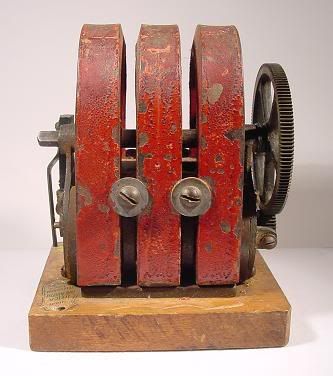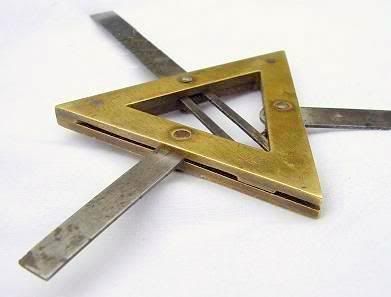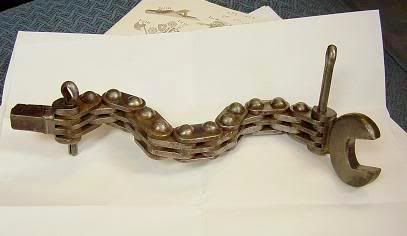811. Telephone magneto, used to signal the operator when you wanted to make a call.



The remaining pictures in this set were shot at the Mid-West Tool Collectors Association meeting last week, thanks to everyone there who allowed me to take these photos of their tools.
812. According to the seller this is a carriage maker's square.


813. Caldwell Boxfindr, a reader of this site explains this device:
Another name for the boxfinder is "dip needle" since it gives an
indication of the angle at which the earth's magnetic field "lines of
force" intersect the horizontal surface, thus the instruction to align the instrument in the N-S plane. The dip angle is affected by the presence of magnetic materials used in valve boxes and/or survey marker bars. This instrument often comes as a rectangular 3x3x2 inch box suspended from a shoulder strap and having an angled mirror to allow the needle and scale to be viewed from above and may be found as part of the equipment carried by most land surveyors.

The full text on the lower face reads:
"Hold vertical with needle
in north and south line
move steadily near
surface over the
suspected area"
814. Anemometer, used by miner's to measure the flow or velocity of air at the entrance to a mine.




815. Knife sharpener, U.S. patent number 538,404, April 30, 1895.


816. This type of scale was used by the ice man when delivering ice. In the Midwest these were also called hide scales and buffalo hide scales.


Updates to answers from previous weeks:
Thanks to Jim Moffet for providing the patent number for the wire shovel, it was number 2,551,978 on May 8, 1951, and was made for "sifting ashes and the like or for the handling of vegetables or other materials".

And thanks to Leon Fisk for finding the information on both of the following:
I had posted that it was marked "barbed wire wrapping tool", but as stated in the Dictionary of American Hand Tools, it originally sold as a valve lifter for automobiles, and is listed in some publications as a fence tool.

Two patents that are very similar to the snake wrench, from September 16, 1919, patent number 1,316,398; and from July 2, 2002 number 6,412,374.

Last week's set is seen below, click here to view the entire post:




The remaining pictures in this set were shot at the Mid-West Tool Collectors Association meeting last week, thanks to everyone there who allowed me to take these photos of their tools.
812. According to the seller this is a carriage maker's square.


813. Caldwell Boxfindr, a reader of this site explains this device:
Another name for the boxfinder is "dip needle" since it gives an
indication of the angle at which the earth's magnetic field "lines of
force" intersect the horizontal surface, thus the instruction to align the instrument in the N-S plane. The dip angle is affected by the presence of magnetic materials used in valve boxes and/or survey marker bars. This instrument often comes as a rectangular 3x3x2 inch box suspended from a shoulder strap and having an angled mirror to allow the needle and scale to be viewed from above and may be found as part of the equipment carried by most land surveyors.

The full text on the lower face reads:
"Hold vertical with needle
in north and south line
move steadily near
surface over the
suspected area"
814. Anemometer, used by miner's to measure the flow or velocity of air at the entrance to a mine.




815. Knife sharpener, U.S. patent number 538,404, April 30, 1895.


816. This type of scale was used by the ice man when delivering ice. In the Midwest these were also called hide scales and buffalo hide scales.


Updates to answers from previous weeks:
Thanks to Jim Moffet for providing the patent number for the wire shovel, it was number 2,551,978 on May 8, 1951, and was made for "sifting ashes and the like or for the handling of vegetables or other materials".

And thanks to Leon Fisk for finding the information on both of the following:
I had posted that it was marked "barbed wire wrapping tool", but as stated in the Dictionary of American Hand Tools, it originally sold as a valve lifter for automobiles, and is listed in some publications as a fence tool.

Two patents that are very similar to the snake wrench, from September 16, 1919, patent number 1,316,398; and from July 2, 2002 number 6,412,374.

Last week's set is seen below, click here to view the entire post:


